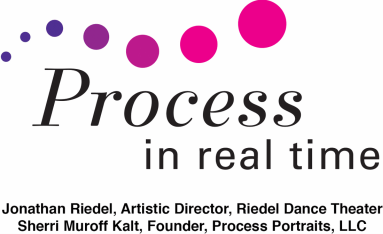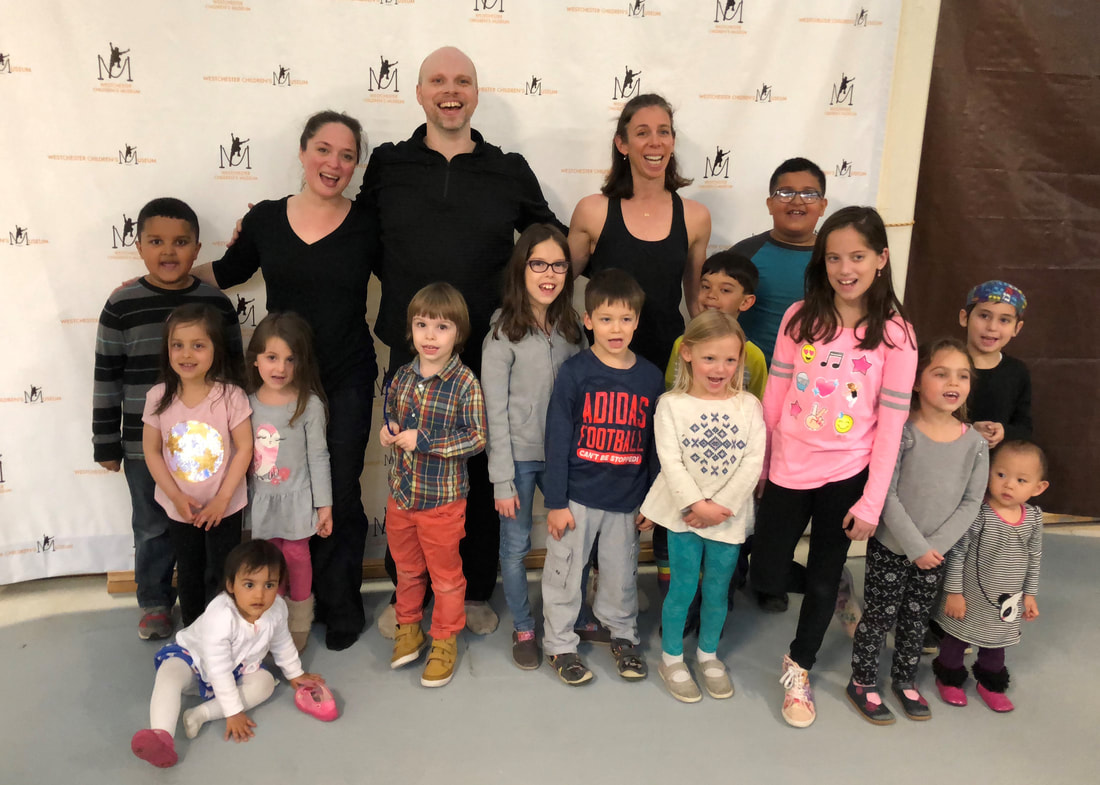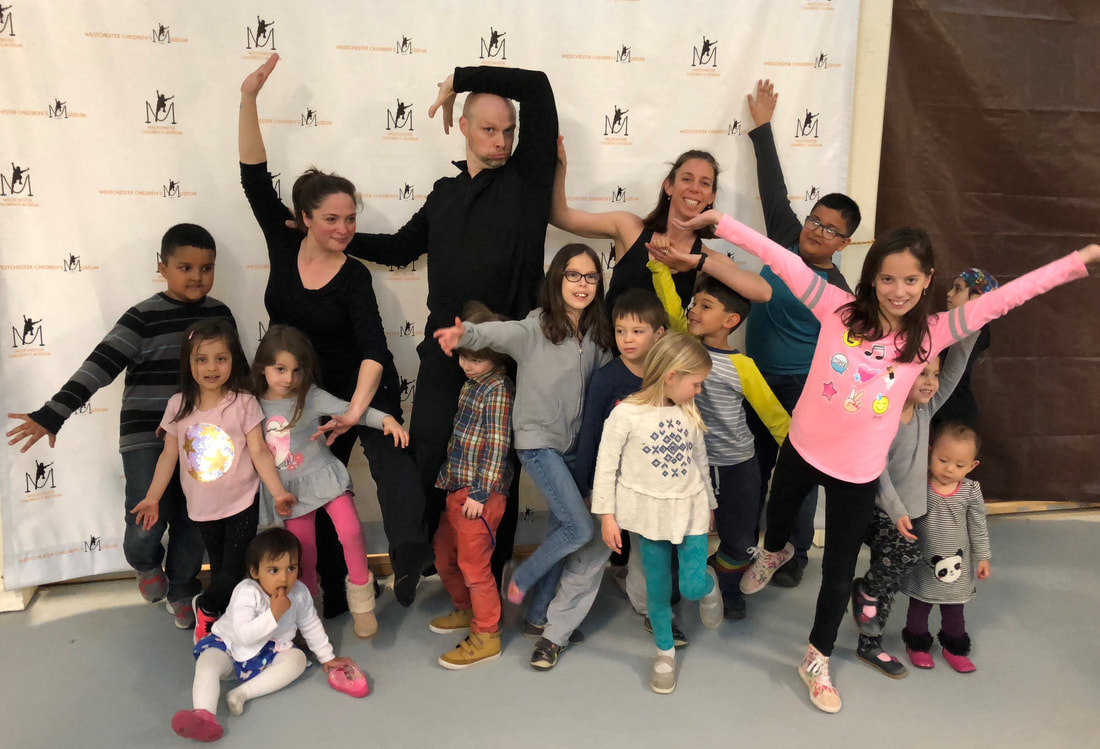|
CHOREOGRAPHIC WORKSHOP IN COLLABORATION WITH THE WESTCHESTER CHILDREN’S MUSEUM April 15, 2018 NEVER TOO YOUNG TO CREATE DANCE It’s a cold, blustery – SPRING! – day – perfect weather to draw young dancers and dancers-to-be to our inaugural “Watch, Do and Make Dance!” workshop in collaboration with the Westchester Children’s Museum!
But first, preparation. The performance space, while private, is filled with support beams. The dancers immediately start calculating how to adjust their dancing and instruction to keep from crashing into the poles. They then determine how best to set up the space, working with makeshift walls and mirrors on wheels, rubber mats, rugs and tables. Edgar, Eliza, Max, and Nate (Sebastian is still napping) are taking full advantage of the space to explore and run around. Sherri works with Nicole from WCM to determine the logistics necessary to get every parent to sign a lengthy release form, giving their permission for their child(ren) to be photographed – all while keeping eager participants from entering the room. Meanwhile, Jonathan, Lorena and Mandy squeeze in a quick warm up before the workshop begins. As the kids and their parents bound into the room, it is clear that the audience is skewing toward the preschool set – with a few elementary school-age kids mixed in. Although the workshop is designed for 6- to 11-year-old children, WCM advised us that kids of any age may want to participate. Moreover, since the museum didn’t request RSVPs or require signing up in any of their marketing materials, there was no way to know in advance how many children would show up. Therefore, the dancers had to be prepared to adjust the program components and instructional approaches to accommodate a variety of ages and an unknown number of participants. We begin the workshop with about 20 children, all accompanied by one or more family members. Jonathan welcomes the audience, introduces the dancers, and outlines the three principal components of the workshop: watching the dancers perform a short section of their recent works, teaching the kids a phrase or two from each piece, then working with the kids to create new material to add on to the choreography they just learned. Jonathan leads the initial portion of the warm up with the kids. He is clearly adjusting his instructions/descriptions to make them accessible to the younger children. He also makes a point of verbally interacting with the kids, putting them at ease and drawing them further into the experience. Edgar and Eliza alternately hug dad’s legs and join in the warm up. While some parents stand on the perimeter of the room, others want in on the action and do the exercises along with their kids. Jonathan warms up each part of the body from head to toe, then moves into marching/jumping/running in place. Side leg kicks, transferring weight from side to side, and varying the height of the body conclude this segment of the warm up. Jonathan then introduces Mandy, explaining that she will lead dance games. Mandy guides and repeats a series of three elements: walking quickly, “freezing” in place, then creating an original shape with the body according to Mandy’s cue. She asks the children to create a total of three different shapes; shape #1 should be made with one elbow touching the ground…shape #2 should be made with the body up against the wall…shape #3 should be created while balancing on one leg. Mandy reviews the three different shapes, then runs through the entire sequence. She encourages the children to remember the three shapes since they will be using them when they create new material later in the workshop. Jonathan reminds the audience of the three components of the workshop (watch us dance, learn a part of the dance, and make up a dance together), introduces Lorena, and tells the kids that they are now the audience so they can watch Lorena dance a section of a piece she choreographed. Jonathan explains that Lorena’s dance focuses on moving to the music. Lorena dances an excerpt from “Voices.” She asks the kids if they remember where in the room she started her dance – they all do! – then leads them to that corner of the room. First, the children practice skipping, galloping and running. Lorena instructs them to skip for 8 counts laterally across the room…gallop for 8 counts on a diagonal…then run anywhere in the room for 8 counts. Lorena then teaches the kids a movement phrase which they will do after skipping, galloping and running. Lorena reviews each form of locomotion, inserting the movement phrase in between each one. Finally, she asks the kids to choose whether they want to skip, gallop or run each time. After a couple of practices, the kids seem quite comfortable with their new material! Jonathan now introduces Mandy, gathering the kids together to be the audience again. He points out that Mandy’s choreography focuses on making shapes with the body. Mandy dances a section from the solo she created for Lorena. She then teaches the kids a couple of movements from her choreography. Referencing the three shapes the kids created in the warm up, Mandy asks them to add these poses to the phrases they just learned. They practice putting it all together – and do so successfully! Jonathan informs the children that he will now show them the final dance of the day, so it’s time for them to be an audience again. He explains that his choreography features a lot of hand gestures and emotional expression. To help them understand his dance, he says he is pretending to be a bird. Jonathan performs a section of “Embers and Ash.” He then asks the children if they saw the emotions on his face – and if they are able to identify them. Was he happy or sad? The kids seem to have different opinions on the subject! Jonathan then teaches a series of gesture phrases, each part in three counts. After the kids practice, Jonathan asks them to come up with ideas for two more movements that a bird might make. Clawing and pecking with a beak are then practiced and added to the gesture phrases – in three counts, of course. Lorena leads the last portion of the workshop, helping the kids put all the new material together. She verbally reviews the choreography the children created with each of the three dancers. Lorena then runs through each of the three new phrases with the kids, in the order in which they were created. The dancers ask the children if they would like to perform the three phrases to music as their “performance.” Although one kid has had enough, the rest agree to do it one more time. Their final move is, appropriately, a bow to their audience! Jonathan then assembles the children into a group for several photos with the dancers. Even though many of the children were quite young, the dancers’ frequent reminders about what they have already done, repeated prompts regarding what comes next, and lots of practice made it possible for all the kids to participate. While some were fully engaged and able to follow along, others seemed content to run around with their peers and enjoy the experience. Although some of the participants came in and out of the room during the program – and others left early – there was a core group of about 12 children that stayed for the full hour! The dancers feel that they achieved their objectives, including exposing children to professional dancers and their original works, enabling kids to learn and create choreography in collaboration with choreographers, teaching the rudiments of dance composition, and encouraging kids to access their creativity and imaginations in new ways. April 11, 2018 FINAL PREP FOR “WATCH, DO AND MAKE DANCE!” WORKSHOP Our session begins today with Lorena consulting with Mandy and Jonathan to finalize the music that will accompany the different segments of our upcoming choreographic workshop at the Westchester Children’s Museum on Sunday, April 18th. Lorena is using her computer to create a CD with the music the dancers select.
At the last rehearsal, the dancers decided to wear teaching clothes for the workshop. Today, they get more specific, agreeing to wear all black. As this is the final rehearsal before the choreographic workshop on Sunday, Jonathan talks through the progression of the program with Mandy and Lorena:
Lorena decides to put on a video for Sebastian so the dancers can focus on a trial run of the program. Sherri is playing the role of an elementary school participant, trying to imagine how she would respond to the dancers’ instructions if she were seven years old! Jonathan, Mandy, and Lorena go through the entire program, one element at a time. Together, the dancers help one another determine the most effective descriptions, verbal cues, explanations, and approaches, given the young age of the workshop participants. The dancers offer ideas and feedback, testing them out in real time. Adjustments are made on the spot. Transitions between elements are worked out. Although the dancers try to anticipate the needs and competencies of the children, they acknowledge the possibility that they may need to adjust the pace and content of the program to respond to the actual levels of energy, interest, and ability the participants present. Everyone is excited to test out our latest choreographic initiative on Sunday! March 28, 2018 PREPARING TO DEVELOP YOUNG CHOREOGRAPHERS For months, we have been solely focused on preparing for our works-in-progress showing that just took place on March 18th. Consequently, we only have 2 rehearsals – today and April 11th – to determine the program details for our choreographic children’s workshop called “Watch, Do and Make Dance!” Designed in collaboration with the Westchester Children’s Museum, this special event will premiere on Sunday, April 15, 2018 at the museum.
Before discussing program content, the dancers consider their clothing options for the workshop. They ultimately decide that they will wear the clothes they usually use for teaching their dance and Pilates classes. Jonathan then offers ideas for a verbal introduction to kick off the workshop. Mandy and Lorena think that Jonathan should be the speaker at the event. They agree with Jonathan that his initial remarks should include an explanation of Second Story’s purpose and unique environment and a summary of the elements of the choreographic program. Jonathan suggests that the workshop begin with a teacher-facilitated warm up with the children. The dancers believe 10 minutes would probably be the longest amount of time they could devote to this segment while retaining the kids’ interest. The team agrees that one dancer will lead the warm up while the other 2 dancers spread out among the children so they can follow the instructor more easily. To determine the contents of this segment, Jonathan, Mandy and Lorena simultaneously offer ideas and demonstrate their execution. The sequence of exercises they select will touch on nearly every body part, going from head to toe. The warm up will feature movements at different speeds, different height levels and in different directions…weight transfers…balancing on one leg and on tip toes…stepping out wide, then together…marching/running/jumping in place…rudimentary phrases such as grapevines…basic rotations/twists. The dancers practice teaching the warm up movements, keeping the age of their audience in mind. Mandy suggests that the dancers conclude the warm up with a game segment in which the kids are asked to make a variety of shapes with their bodies, based on Mandy’s prompts. She proposes using cues tied to shapes, different height levels, and character imagery. This way, the children gain some experience with creating material early in the program that will facilitate the generation of choreographic ideas later. The team agrees with Jonathan’s outline of the rest of the program:
Time to choose the phrases to perform and teach: Lorena
Lorena, Mandy and Jonathan then practice “teaching” the phrases to one another and coming up with verbal and physical cues that will help the kids generate new material. Next, the dancers imagine working with the children to combine all 3 new sections of material. They realize how this process will be a great lesson in learning about choreographic structure/geometry. Interspersed throughout rehearsal today, the dancers suggest and play on their phones a number of pieces by Phillip Glass, So Percussion, Mickey Hart, and Hang Massive that could be used for the warm up and creation of original work. Lorena volunteers to make the final selections from these options and create a CD for the workshop. Meanwhile, Sebastian has been largely absorbed in watching videos, racing toy cars around the room, and joining the dancers as they test out Lorena’s aerobically exciting choreography. Nevertheless, Lorena repeatedly transitions between creating and caregiving to attend to a variety of Sebastian’s needs. The dancers make a lot of progress today. With one more session to practice each element of the program, they will be ready to launch this exciting new choreographic workshop! |
AuthorsSherri Muroff Kalt, founder of Process Portraits, LLC and author of Portrait of an Artistic Journey: The Creative Process in Real Life Context, is a Phi Beta Kappa, magna cum laude graduate of Duke University with a B.A. in psychology. She began her career in marketing and sales in New York City with L’Oréal, Monet Jewelers, and Givenchy. READ MORE |



 RSS Feed
RSS Feed